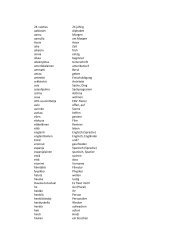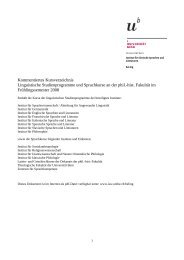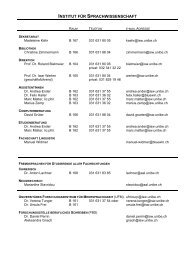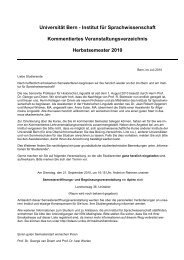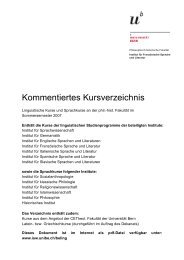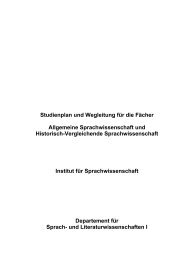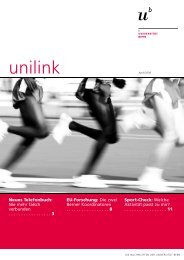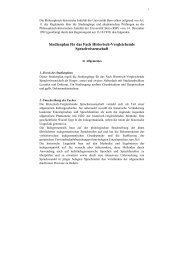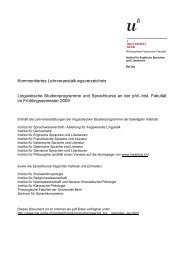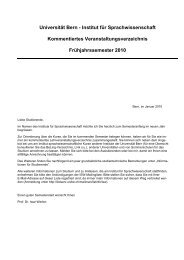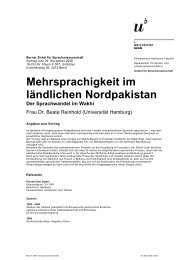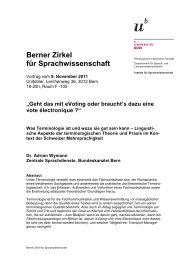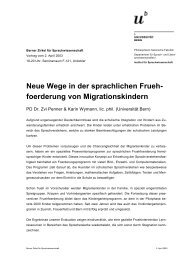The expression of modality in Korean - Institut für ...
The expression of modality in Korean - Institut für ...
The expression of modality in Korean - Institut für ...
Create successful ePaper yourself
Turn your PDF publications into a flip-book with our unique Google optimized e-Paper software.
26<br />
genetic label on <strong>Korean</strong> 25 . Today, however, two ma<strong>in</strong> theories rema<strong>in</strong>. <strong>The</strong> older theory claims<br />
that <strong>Korean</strong> is a member <strong>of</strong> the Altaic language family 26 and attempts to f<strong>in</strong>d a l<strong>in</strong>k between<br />
<strong>Korean</strong> and the Altaic languages were made practically as soon as the language family itself<br />
was established 27 , but it was the works <strong>of</strong> Ramstedt 28 which advanced <strong>Korean</strong> genealogical<br />
studies to a new level. <strong>The</strong> view that <strong>Korean</strong> is supposedly an Altaic language, belong<strong>in</strong>g to<br />
the Eastern branch (along with e.g. Mongolian and Tungus) and form<strong>in</strong>g an <strong>in</strong>dividual<br />
language sub-group 29 , is today shared by many scholars <strong>in</strong> this field, although one cannot<br />
claim that substantial pro<strong>of</strong> has ever been put forward. Today, the complexity <strong>of</strong> the question<br />
<strong>of</strong> genetic affiliation <strong>of</strong> <strong>Korean</strong> to other languages may dictate an approach detached from the<br />
general classification labels. In all probability (and this is the second, more recent theory)<br />
<strong>Korean</strong> is an <strong>in</strong>dependent language, <strong>in</strong> the sense that it was located <strong>in</strong> an area which turned<br />
out to be a major zone <strong>of</strong> contact for different language families, leav<strong>in</strong>g traces <strong>in</strong> the<br />
language <strong>of</strong> the <strong>Korean</strong> pen<strong>in</strong>sula.<br />
A discussion l<strong>in</strong>ked to the above is the question <strong>of</strong> whether <strong>Korean</strong> and Japanese share<br />
a close genetic relationship. This claim was seem<strong>in</strong>gly first put forward by the Confucian<br />
scholar Hakuseki as early as 1717; the first explicit l<strong>in</strong>guistic study <strong>in</strong> this direction was<br />
made by Aston (1879). Studies by Japanese scholars such as Kanazawa (1910) are<br />
25 <strong>The</strong> l<strong>in</strong>ks proposed reach out <strong>in</strong> all four directions (east, west, south. and north) and <strong>of</strong>fer a strong difference <strong>in</strong><br />
the degree <strong>of</strong> l<strong>in</strong>guistic likelihood. <strong>The</strong> East theory claims that the <strong>Korean</strong> people orig<strong>in</strong>ated from the east,<br />
namely Japan, and that Old <strong>Korean</strong> was merely an early variety <strong>of</strong> Japanese spoken on the <strong>Korean</strong> pen<strong>in</strong>sula.<br />
This po<strong>in</strong>t <strong>of</strong> view, put forward by imperialist Japanese scholars, had a colonialistic motivation and as such can<br />
be dismissed without further discussion. <strong>The</strong> West theory has two unrelated proposals, the first <strong>of</strong> which was<br />
propagated by Hulbert (1905) who argued that <strong>Korean</strong> was related to the Dravidian languages. This claim was<br />
based on the observation that <strong>Korean</strong> and the Dravidian languages share a number <strong>of</strong> similiarities, which he<br />
considered suggestive <strong>of</strong> a genetic relation (surpris<strong>in</strong>gly, this l<strong>in</strong>e <strong>of</strong> thought was taken up aga<strong>in</strong> by Clipp<strong>in</strong>ger<br />
(1984)). <strong>The</strong> second proposal with<strong>in</strong> the West theory is an attempt, put forward ma<strong>in</strong>ly by Eckardt (e.g. 1923,<br />
1966) and taken up by e.g. Koppelmann (1933), to relate <strong>Korean</strong> to Indo-European. Apart from what may be<br />
called archaeological and ethnic material, this approach is based ma<strong>in</strong>ly on lexical comparison. Eckardt’s list <strong>of</strong><br />
believed lexical correspondence <strong>in</strong>cludes items such as iss (be; Greek esti, Lat<strong>in</strong> esse, German ist) or kul (cave,<br />
hole; Sanskrit guh (hide), Greek koilos (hollow), Tocharian kukul (hole)). Very much like Hulbert’s proposal,<br />
this attempt to classify <strong>Korean</strong> is based on mere co<strong>in</strong>cidences. It is therefore <strong>of</strong> no surprise that both have been<br />
reduced to a status <strong>of</strong> historical <strong>in</strong>terest only. <strong>The</strong> South theory argues that the people <strong>of</strong> Korea, along with others<br />
<strong>in</strong> the region, orig<strong>in</strong>ated from the Malayo-Polynesian area. This proposal is more <strong>of</strong> an ethnographic rather than<br />
a l<strong>in</strong>guistic nature, attempt<strong>in</strong>g to expla<strong>in</strong> the common traits <strong>in</strong> anthro-archaeological f<strong>in</strong>d<strong>in</strong>gs, agriculture,<br />
mythology, etc. <strong>The</strong> l<strong>in</strong>guistic material, however, is rather less strik<strong>in</strong>g. <strong>The</strong> theory, therefore, cannot be<br />
accepted as conv<strong>in</strong>c<strong>in</strong>g by l<strong>in</strong>guists. <strong>The</strong> North theory connects <strong>Korean</strong> to the Altaic language family and is<br />
discussed <strong>in</strong> further detail with<strong>in</strong> the ma<strong>in</strong> text.<br />
26 <strong>The</strong> term „Altaic“ was first used systematically by Klaproth (1823) and elaborated by Schott (1849). Generally,<br />
the Altaic languages are seen as one <strong>of</strong> two major branches with<strong>in</strong> the Ural-Altaic language family (cf. e.g.<br />
Ruhlen (1976) or Voegel<strong>in</strong> & Voegel<strong>in</strong> (1977)).<br />
27 Klaproth (1823) himself was followed by e.g. Boller (1857). <strong>The</strong> most important publication before the works<br />
<strong>of</strong> Ramstedt, however, is that <strong>of</strong> Polivanov (1927).<br />
28 Apart from his <strong>Korean</strong> Grammar (first published <strong>in</strong> 1939, repr<strong>in</strong>ted <strong>in</strong> 1968), Ramstedt ma<strong>in</strong>ly worked on the<br />
lexicon with the goal <strong>of</strong> establish<strong>in</strong>g a l<strong>in</strong>k with the Altaic language family (e.g. 1949, 1952, 1957).<br />
29 This detailed classification model was put forward by Miller (1971).



